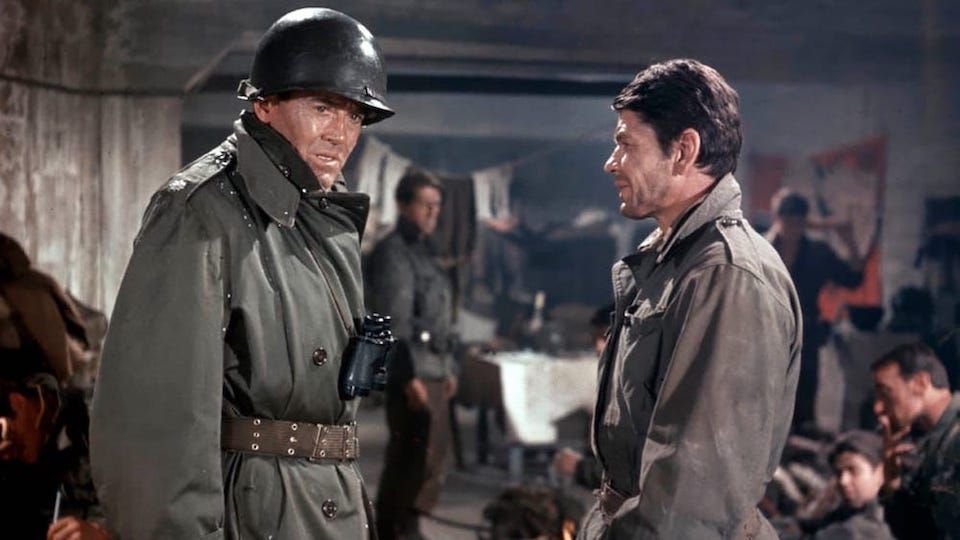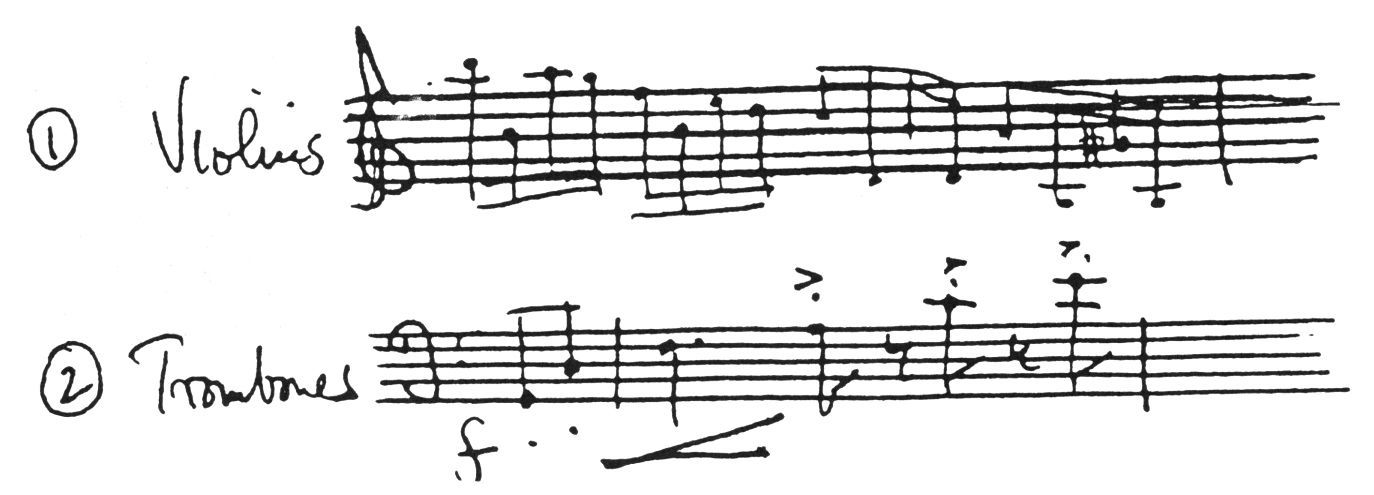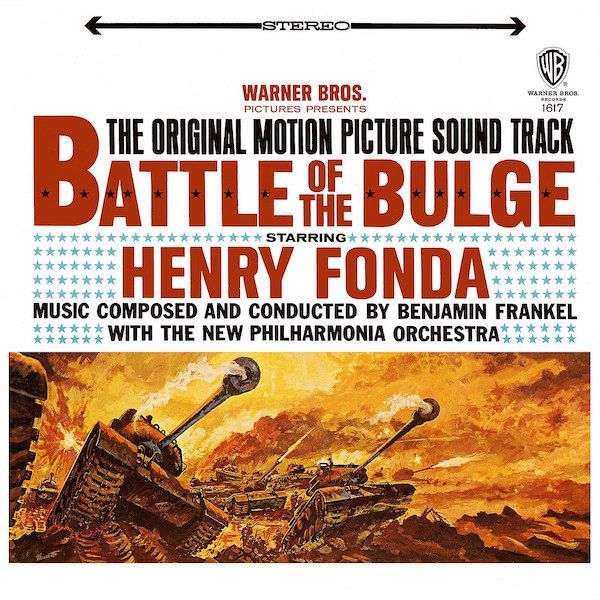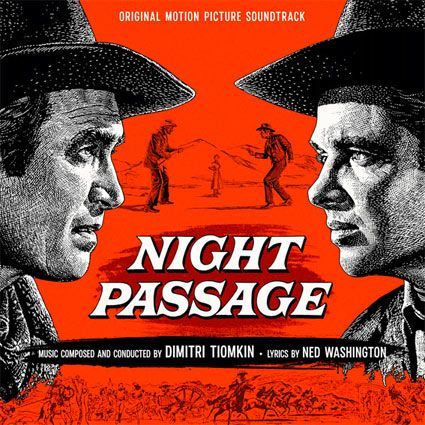- Prelude (2:57)
- Kiley’s Plane Chases Hessler’s Car (3:34)
- Panzerlied (The Tankmen’s Song) (2:22)
- Interlude with a Courtesan 1st Class (2:51)
- The German Tanks Emerge and Break Through (7:22)
- 1st Tank Battle (8:54)
- The Massacre of the American Prisoners (3:10)
- The Attack on the Fuel Depot Fails and Hessler is Killed (6:38)
- The Panzermen Abandon their Tanks: Victory and Postlude (2:13)
Battle of the Bulge

Originally published in Music from the Movies: Issue 1, 1992, pp 10-14
Text reproduced by kind permission of the editor, Paul Place
Buxton Orr, one time pupil, colleague and friend of Benjamin Frankel, was actively involved in the conducting and recording of the film track and of the present disc. He is the author of the article on Frankel’s concert music in the current edition of Grove.
A disc of extracts from a film score, cooked up in the last days of the film recording sessions, is bound to be less satisfactory than a properly assembled concert suite, especially as endings tend to be written to fade into the ensuing dramatic action. However, such is the quality of Frankel’s music, and this goes for his entire output of film scores, even when under extreme pressure of time, there was never resort to crude padding and the musical thinking stands up superbly on its own. Further, in this case, there is a special advantage in listening to the disc. As I understood it, Ben’s brief was to support the many war scenes purely by the strength of the musical score. “We’re not going to indulge purely in the usual cliché of sound effects. Let the music speak!”. Characteristically, Ben rose to the challenge. Equally characteristically, in the final dub, the music was, as ever, all but obliterated by the roar of tanks and the explosion of guns. At least on the disc we can now appreciate Ben’s musical imagination at full descriptive tilt.
Track 1 – Prelude: The title music in its final form for there is internal evidence of a major last-minute extension is in essence a summary of the total plot of the film.The march-like figuration of the dramatic opening gives way to a bizarre presentation of the Panzerlied that serves throughout as a leitmotif for the German forces. Here it is heard on the Tuba, accompanied ponderously by a device first used by Ben in his Second Symphony, the dropping of a bag of chains on the Bass Drum. As in all the battle-descriptive passages one should note the use of vivid figurations, always appropriate to the instrumentation and constantly varied in colour, harmony and rhythmic displacement, never merely repeated. Two examples could be quoted from this track:

The eventual triumph of the American forces is foreshadowed here by the big C major Chorale we hear at the end of the film:

Space does not allow quotation of the whole, Chorale which develops from this deceptively obvious opening, or of the vivid major/minor figures that punctuate its progress. The track ends with a characteristic inverted ninth chord (Ben would claim not to know what that meant!) for the music to dissolve into the first scene.
Track 2 – Plane Chase: The high string accompaniment suspends us in space as the American Colonel Kiley (Henry Fonda) searches from his plane for the Germans. Kiley has his own Theme:

As they zoom down, spotting the car containing Colonel Hessler (Robert Shaw), the music picks up tempo and vividly describes the ensuing chase. Aggressive themes associated with the Germans include the following:

Track 3 – The Panzerlied: A loyal, solitary, voice strikes up the Horst Wessel-like song; joined by the rest of the Panzer tank men and soon backed by a military band accompaniment. One understands Frankel’s original reluctance to use such thematic material (after all, his Violin Concerto was written in memory of ‘the six million’) but he must have got much pleasure out of track 8 when the sound of the Panzerlied is musically crushed under the weight of the whole orchestra!
Track 4 – Interlude: Hessler is offered the consoling services of high-class call-girl, and the lilting little tune that accompanies this section is heard on high Violin harmonics and their appropriate colour of a wolf whistle! Note the musical transformation of the melodic line as Hessler rejects with dignity the General’s ‘little present’ and turns his mind to more serious matters.
Track 5 – The German tanks break through: Not only the two main themes, but their contrasting tonalities give strength to the conflicts described in this long and varied section. Of many striking ideas, note the irregular metre of opposing trumpet and trombone fanfares, culminating in a passage for the two sets of four timpani. The temporary defeat of the Americans is described by Kiley’s theme on horns sustained by moving string chords, a chattering marimba and the poignant comment of the piccolo trumpet in its highest register.
Track 6 – First Tank Battle: In this, the attempted counter attack by the Americans, their confidence is characterised by the following jaunty themes:

The second has been described as virtually a ‘hoe-down’. The more steady American optimism is associated with the next theme:

Not just the music, but a lot of the film for which this section was written appears to have ended on the cutting room floor, so you can listen, enjoy and write your own scenario.
Track 7 – The Massacre of American Prisoners: The tolling bell of the opening describes the foreboding of the prisoners as they are taken to the woods. Much music is under the dialogue of two of them and theme 9 is heard, poignantly on the high trumpet, before sheer panic breaks out as the machine guns are revealed. The final cadence makes moving comment on the sight of the field of corpses.
Track 8 The Fuel Depot: The slow opening and its many thematic references describes, amongst many other things, the attempt of some Germans to impersonate American soldiers. Hence the many stages of uncertainty as various figures are pitted against each other and polytonal conflicts abound. The big theme is heard as the Americans roll ignited oil drums down on to the German tanks. Hessler’s tank explodes and we hear the singing of the Panzerlied crushed and distorted under the dissonance of the full orchestra.

Track 9 – Postlude: Abandoned tanks and dejected German troops is described by the clump of chains, a dejected rattle on the side-drum and the Panzerlied moaned by the solo Tuba. The Victory Chorale (ex 3) brings the film to an end with triumphal tubular bells and a C major cadence.




